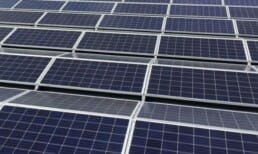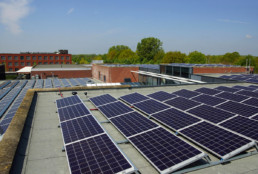Paneles solares Autarco en ruta hacia el Polo Sur
A finales de noviembre, Edwin y Liesbeth partieron hacia el Polo Sur para su misión “Clean2Antarctica”. La primera expedición de energía neutral y cero residuos al Polo Sur, con el objetivo de llamar la atención sobre el cambio climático e inspirar a las personas a tomar medidas.
El viaje de 30 días de 2400 kilómetros conduce a través de un desierto de hielo donde el sol nunca se pone. Lógico que la energía solar se elija para el accionamiento. Su Solar Voyager consiste de un camión y dos remolques que están equipados con diez paneles Autarco para la conducción. Debido al fuerte reflejo de la nieve, se han elegido los llamados paneles bifaciales, en los que ambos lados generan electricidad. Los paneles están unidos con un sistema extraíble, si el viento sopla demasiado fuerte, la fila superior debe retirarse para que el remolque no se caiga. Con aún más viento todo se dispara y el Solar Voyager echa el ancla.
La Madre Naturaleza decidió que después de ochenta kilómetros, Edwin y Liesbeth tuvieron que detener su viaje temporalmente debido a una tormenta de nieve. Esto tomó un día y medio y un día después, volvió a suceder. Pero como dice Edwin “incluso si no siempre nos gustan las turbulencias, a veces las necesitamos, solo un poco. La turbulencia se puede poner en movimiento y un nuevo estado de cosas.”
Autarco benoemd in top 3 innovatieve bedrijven
Anne-Marie Rakhorst is een succesvol ondernemer en een veelgevraagd spreker over duurzaamheid. In het programma Booming Brabant spreekt ze haar persoonlijke top 3 van meest innovatieve Brabantse bedrijven uit. Autarco staat in deze top 3 vanwege de ‘echte vraaggestuurde oplossing die ze bieden’.
A performance boosting summer
With last year’s long and hot summer not yet forgotten, it will not come as a surprise that 2018 was a good year for the owners of PV systems. But how does this year relates to previous ones? What does it mean for the long term performance of PV systems? Autarco’s engineers collected the data and found out.
What was the influence of the long summer?
In a previous blog on this site, we already saw that February 2018 was a very sunny month, related to other Ferbruary months. But the graph below also shows that this is of little impact on the year’s total yield, since it is only a small part of it. Of course, it’s the summer months that count. Typically, in the Netherlands you will generate 40 to 45% of a total year’s yield in May, June and July, when the days are longest and the sun is high in the sky. In 2018, these months were particularly sunny and warm, pushing the total irradiance for 2018 to values 8 to 15% above the long term average.

Average irradiance per day (W/m²)
15% more irradiance, what’s the deal?
The next graph shows the yearly irradiance for five locations in different parts of the Netherlands. First thing to notice is the year to year deviation. It also shows that 2018’s high irradiance levels are quite rare, we need to go back fifteen years to find similar values. As an installer or (potential) owner of a PV system, it might be tempting to consider yourself well off, based on last year’s yields. But it’s because of these deviations in the graph, that last year’s peak irradiance gives us no information whatsoever for the coming years. Therefore it is of great importance to keep looking at long term averages, in order to obtain realistic expectations on yields.
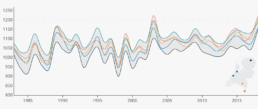
Total yearly irradiance (kWh/m²)
So what does this mean for my PV system?
In terms of the yield of any PV system, the irradiance alone does not tell the complete story. Sure, it’s important, but yield is also affected by the pitch and azimuth of the modules, the system’s efficiency and shade losses.
Autarco’s design and monitoring software has all the answers. By modelling a PV system, an exact virtual copy is created, where all the yield influencing aspects as described before are taken into account. Based on the design a yield prognosis is calculated, using the long term average irradiance for the exact location of the system. This makes it possible to very accurately calculate the return on investment for any PV system, and is much more secure than the standard figures still used to estimate yields in terms of kWh per kWp. After all, these numbers do not tell the whole story and are often too high.
After installation and registration of an Autarco PV system, the installation is verified to be sure that it is exactly similar to its virtual twin. By doing so, Autarco is able to monitor performance on all of its systems with great accuracy. We don’t look at standard figures and estimates whatsoever, based on the virtual twin and the actual meteorological satellite data, we know exactly what a system’s yield should be at any time. By comparing this with the actual yield as communicated by the inverters, we know immediately when something’s wrong and maintenance or repairs should take place.
Find out more on our design software here.
Wat betekent een goede zomer voor mijn jaaropbrengst?
Met de lange, warme zomer van het afgelopen jaar nog vers in het geheugen zal het geen verrassing zijn dat 2018 een goed jaar was voor de eigenaars van PV-systemen. Maar hoe verhoudt dit jaar zich tot eerdere jaren? En wat betekent dit voor de prestaties van PV-systemen op de lange termijn? De engineers van Autarco verzamelden de data en zochten het uit.
Hoeveel invloed had de lange, warme zomer?
We hebben in een eerdere blog al gezien dat februari naar verhouding een behoorlijk zonnige maand was afgelopen jaar. Tegelijkertijd maakt de onderstaande grafiek duidelijk dat de impact hiervan klein is, de grootste opbrengsten worden immers niet gehaald in februari, maar in de zomermaanden. Gemiddeld genomen wordt in Nederland circa 40-45% van de jaarlijkse opbrengst behaald in de maanden mei, juni en juli, wanneer de dagen het langst zijn en de zon het hoogst aan de hemel staat. Deze maanden waren vorig jaar uitzonderlijk zonnig en warm, waarmee de totale instraling voor 2018 maar liefst 8 tot 15 procent hoger ligt dan het langjarig gemiddelde.

Gemiddelde instraling per dag (W/m²)
15% meer instraling, hoe bijzonder is dat?
De volgende grafiek toont de jaarlijkse instraling voor een aantal locaties in Nederland. Hieruit wordt direct duidelijk dat deze waarden van jaar tot jaar behoorlijk variëren. Ook blijkt dat de hoge instraling van vorig jaar niet vaak voorkomt, het is vijftien jaar geleden dat we voor het laatste dergelijke waardes zagen. Het is misschien verleidelijk om je als installateur of (potentiële) eigenaar van een zonnestroomsysteem rijk te rekenen op basis van de hoge opbrengsten van afgelopen jaar. Maar vanwege de schommelingen in de grafiek zegt de piek van 2018 niets over de te verwachten opbrengsten in 2019. Het is daarom belangrijk om naar een langjarig gemiddelde te kijken om een realistisch beeld te krijgen van de verwachte opbrengst van een PV-systeem.

Totale jaarlijkse instraling (kWh/m²)
Wat betekent dit voor mijn PV-systeem?
Een hoge instraling zegt natuurlijk niet alles over de prestaties van een systeem, deze worden immers ook beïnvloed door de hellingshoek en oriëntatie van de panelen, de efficiëntie van het systeem en verminderde opbrengst door schaduw op de panelen.
De ontwerp- en monitoringsoftware van Autarco biedt uitkomst. Met het modelleren van een PV-systeem wordt een exacte virtuele kopie gecreëerd, waarin alle hierboven benoemde aspecten worden meegenomen. Op basis van het ontwerp wordt een verwachte opbrengst berekend, die uitgaat van de langjarige gemiddelde instraling voor exact de locatie van het systeem. Dit geeft een zeer accuraat beeld van de te verwachten baten van de investering en biedt veel meer zekerheid dan de kengetallen waarmee opbrengsten geschat worden, in termen van kWh per kWp. Deze vertellen immers niet het gehele verhaal en zijn vaak aan de hoge kant.
Na installatie en registratie van een Autarco PV-systeem wordt de installatie geverifieerd, om er zeker van te zijn dat de fysieke installatie identiek is aan zijn virtuele kopie. Op deze manier kan Autarco zeer nauwkeurig de prestaties van al haar systemen monitoren. We kijken immers niet langer naar rekenwaardes en kengetallen. De combinatie van het ontwerp in de software en het gebruik van actuele satellietdata zorgt ervoor dat we exact weten wat een systeem zou moeten opwekken. Door dit te vergelijken met de monitoringgegevens van het systeem, weten we direct wanneer een systeem minder presteert dan verwacht en er onderhoud of een reparatie uitgevoerd dient te worden.
Meer over onze ontwerpsoftware vindt u hier.
Operations & Maintenance for rooftop solar
The Operations & Maintenance (O&M) Best Practices Guide Version 3 was released last week at the annual O&M and Asset Management Conference in London. The latest version, developed by Solar Power Europe together with industry experts, now includes a chapter on distributed solar of which Autarco is very proud to be the leading author. The Guide is an excellent resource and we highly recommend all of our Dealers to take the time to read it carefully. O&M is not only critical to guarantee the long term performance of systems, but is also a huge opportunity for Dealers to develop long term relationship with their customers and generate stable and recurring revenue.
Recognition of Autarco's industry leadership.
The Guide covers key topics such as;
- Key Performance Indicators
- Recommended Response Times
- Innovations and Trends
In recognition of the hard work and expertise provided by Autarco in the development of this chapter, our CFO, Dan Horan, was invited to make a keynote speech to introduce the new chapter. He explained during his presentation, “In the utility sector, asset owners are professionals who are knowledgeable about the risks of solar and have assistance from independent engineering, legal and insurance experts. As a result manufacturers, EPC’s and O&M suppliers are held accountable over the full 25-30 year life of a system. In contrast, distributed/rooftop system owners are preoccupied with other matters and don’t necessarily know the first thing about solar. This is made worse by the traditional distributed supply chain which involves a flow of individually branded components that flow through distributors, installers and then finally to the system owner. In most cases the risk and complexity flow down with the components and accumulate with a system owner who is ill-equipped to deal with them and often forgotten after installation.”
Best practises maximise return on investment.
One of our primary purposes at Autarco is to simultaneously remove that risk from both the system owner and the installers. We do this by remaining a stakeholder in the systems performance:
- Being accountable for the quality and performance of our products.
- Providing the necessary tools to our Partners to ensure the system design, install and financial modelling is done to the highest standard with the highest ease.
- Providing intelligent operations (monitoring, alerting and diagnosis) and asset management (reporting) software to our Partners to enable them to easily provide maintenance services (or outsource if preferred).
- Insuring the risk of lower irradiance and product defects
“You can’t guarantee long term performance of the best products in the world without taking long term care of them.”
Dan Horan – CFO Autarco
In partnership with our dealers.
We have complete confidence in the quality of our products, we know our partners do a great job on install and design, the final piece is to make sure long term operations and maintenance is done to the same high standards. As Horan states “You can’t guarantee long term performance of the best products in the world without taking long term care of them”. Together with our Dealers we can provide the same level of security and profitability that utility asset owners demand to our rooftop customers. Of course, if Dealers only want to install we can arrange another O&M provider to take over this responsibility.
If you are a solar installer who wants a full service end-to-end hardware and software solution that improves your bottom line, while offering your customers the best proposition in the market please get in touch with us today.
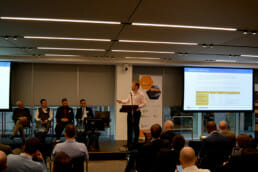
The argument for now
The installed price of solar PV systems has decreased by an incredible 70% over the past 5 years, leading many potential solar owners to question whether they should invest now or wait for further price decreases. The answer for potential beneficiaries of the Dutch SDE+ program is clear; there is no better time than now.
Install costs in solar are decreasing...
The increased price competitiveness has driven the solar industry to record installations in 2017 of a massive 80GW compared to 20GW in 2012. As a result, solar is now at grid parity in many parts of the world and we even see solar projects breaking ground in regions where there are additional taxes applied on solar as opposed to supporting subsidies. This is undoubtedly brilliant news, but it also gives rise to a common question asked by end customers; “If the price decreases so rapidly, why should I invest now? Isn’t it better for me to wait until solar is even cheaper and then invest?” There is sometimes strong merit in this argument and it can only be answered on a case by case situation per market.
“Value of SDE+ Payments decreases over 40% in 3 years”
... but so is the SDE+ subsidy.
For the Dutch market however, particularly the commercial SDE+ market, the answer is a resounding “DO NOT DELAY”. Potential owners should be absolutely utilising any SDE+ subsidy allocated or making the effort to apply during the current Autumn 2018 round due to close in October. Even considering the urgent need for everyone, individuals and businesses alike, to take action in reducing CO2 emissions to limit global warming, there is a purely economic decision to act now: acting now maximizes the lifetime returns of your solar system.
There are 4 primary factors that determine the financial performance of any solar system over a 15 year investment window. You can of course perform the same analysis over 20 or 30 years if desirable, but for the purpose of this article we take the 15 year subsidy period.
| SDE+term | SDE+rate | Self-consumption correction | Change from year 1 | Deadline |
|---|---|---|---|---|
| 2015 | € 0.096 | no | – | Signed contract within 1 year, commissioning within 3 years |
| Spring 2016 | € 0.084 | no | -12.5% | Commissioning within 3 years |
| Autumn 2016 | € 0.084 | no | -12.5% | Commissioning within 3 years |
| Spring 2017 | € 0.092 | no | -4.2 | Signed contract within 1 year, commissioning within 3 years |
| Autumn 2017 | € 0.084 | no | -12.5% | Commissioning within 1.5 years |
| Spring 2018 | € 0.062 | yes | – | Commissioning within 1.5 years |
| Autumn 2018 | € 0.056 | yes | -42.2% | Commissioning within 1.5 years |
*The SDE+ rates in this table assume the highest price brackets and standard correction rates as published by RVO. In the case of the 2018 subsidy, a self use percentage of 50% is taken into account. This number will differ between projects, but even with a theoretical self use of 0%, the maximum subsidy is lower than years before. We are looking at systems <1 MWp.
Why investments in solar should not be postponed.
These data demonstrate a compelling case to invest now! If you have a SDE+ subsidy already approved, the lost opportunity for letting this lapse in the hope of reapplying later when solar costs are lower is clearly a fallacy that is not going to turn out like you hope. Furthermore, with more parties stepping into solar, competition for SDE+ budget is getting harder, leading to smaller chances of getting your request for subsidy awarded.
Recent changes in the Chinese market have resulted in price reductions and further changes to the global supply-demand situation are possible in the coming months. We will soon cover these impacts on the European market, both negative and positive, following the final MIP decision and further clarity on tariffs in key markets like India, Turkey and the US. Even these product price decreases don’t compare with the opportunity cost of failing to act now.
Potential system owners who look at falling module prices and think waiting is the best option, can be convinced to act now by emphasizing three key points;
- Benefit and availability of SDE+ subsidy is decreasing at a faster rate.
- Improving global economics is already pushing interest rates higher. Increasing one of the major costs of any solar projects.
- We need climate action now.
If you have SDE+ customers who aren’t convinced or looking for something extra to convince them we are ready to help. Get in touch to offer a fully secured business case.
Do modules like this summer heat?
July was hot this year. Very hot. But this nice summer weather is good news for your solar modules, right? Or is it? In this article we look at the influence of these conditions on PV systems.
Due to the bright sun, at almost the highest point in its orbit and with hardly any clouds in the sky, irradiance reached record heights over the last couple of weeks. As shown in the graph below, in the Netherlands irradiance was 25-30% higher than the long term average.
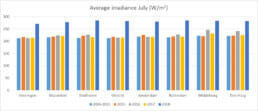
So there was a lot of energy coming our way, ready to be harvested by solar modules. But this great irradiance comes with high temperatures, that surely didn’t go unnoticed. Tarmac was melting, bridges expanded until they wouldn’t open anymore, and crops drying out on the fields. The question now is, how do your PV systems react to this heat? Do they thrive under these conditions? Or are they taking it easy, as we humans tend to do?
Heat
It might sound counterintuitive, but where solar panels love the sun, the don’t particularly like the temperature coming with it. Solar modules are meant to convert light into electricity, not heat. To see exactly what this heat means for the yield of a PV system, we conducted a case study for an installation in our hometown Eindhoven. In this example, we are looking at a set of modules facing South, in an optimal 35° pitch. Looking into the meteorological data we collect on a daily basis, the average temperature in Eindhoven appeared to be around 3°C higher than the long term average. But because this higher ambient temperature is combined with the high irradiance and the heat generated by the modules themselves, it causes the average cell temperature to be 6°C higher than normal, easily reaching values as high as 60°C! This is bad news, because solar modules become less efficient in high temperatures, as do all semiconductors. Higher temperature means a lower potential difference within the cells, which results in lower voltages. And although the current might be a bit higher in situations like these, it doesn’t compensate the lower voltages, resulting in lower yields. After all, the output in watts is the product of voltage and current.
Effects
For our test case, irradiance for July was 34% higher than the long term average. At first glance you might expect yields to raise accordingly. Due to temperature losses, they don’t. The yield this month was only 30% higher, the difference being caused entirely by the high temperatures. As expected, this difference is higher than in previous years with their slightly milder summers. Usually, we look at a difference of around 1,5%, rather than the 4% for this year.
So yes, this sunny summer weather leads to higher yields for your solar modules. However, not exactly as high as you might expect. But while overall efficiency might be a bit lower, due to the high irradiance and the number of daylight hours, July will still be the best month of the year, as it is every year.
Temperature is only one of the many factors that influence the yield of a PV system. All of these values are taken into account in our design software, so it can accurately calculate the expected yields for any PV system. These exact calculations form a major part in Autarco’s insured kWh guarantee.
kWh Face Off! East-West Vs South
Every time a commercial flat roof PV system is designed a decision to build facing South or East-West must be made. While everyone knows European solar systems will perform best facing South with a decent sized pitch, there are a number of other factors at play that influence the most profitable solution for a commercial PV system owner.
Many analyses of East-West vs South facing PV systems for commercial projects still focus on year 1 costs (price per Wp) and estimated production. In the same way that we offer a kWh Guarantee that offers reduced risk and simplicity to installers and system owners, we believe the East-West vs South question is best considered looking at the returns on investment and the levelized cost of energy. After all, solar PV customers are not looking to solve a one-off component hardware problem priced in EUR/W, they are looking for a long term energy solution.
This long term energy solution needs to consider the total costs related to the yield of a system for its complete lifespan and of course the risk related to the solar production over the same lifespan. So what are the expected returns of a solar system?
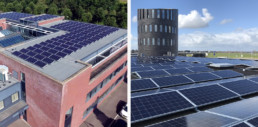
Comparison.
Let’s look at an example where we compare both alternatives for a reasonably sized commercial project in the Netherlands. We cover some of the assumptions we have made in detail below.
Over the 15 year life of the Dutch SDE+ subsidy, the system owner can generate nearly 20% more profit with an East-West system at a slightly higher return on investment. While a south facing system in the Netherlands does produce nearly 7% more yield per Wp, this power is more costly given the current solar economics of 2018.
| Azimuth | Annual yield per kWp (kWh/kWp) | Annual yield per m² (kWh/m²) | Annual savings (€) | Cost of energy produced over 15yrs (€/kWh) | ProjectIRR * |
|---|---|---|---|---|---|
| East-West | 934 | 127 | 20,443 | 0.059 | 19.30% |
| South | 997 | 100 | 16,000 | 0.076 | 17.20% |
*IRR excludes any fiscal/tax benefits
Autarco’s insured kWh Guarantee lowers the risk profile of the project for the bank, helping system owners and investors unlock more debt at lower costs. As a result, the additional initial investment required for an East-West system should not be a barrier to completion.
The drivers behind this result and some of the key factors to consider are discussed below. Regardless of the choice, Autarco’s kWh Guarantee, insured by Lloyd’s of London, delivers peace of mind to both installers and end customers by providing a minimum production level that protects your investment.
Yield per wattpeak.
| Assumption: | Face Off result |
|---|---|
| Base Assumption: 10/12 degrees | Win for South. 7.3% more yield/Wp. |
| Factor: Greater module pitches | A 30 degree pitch south system will produce 13% more than a 10 degree pitch East-West system. |
As we all know, the yield per modules it at its best when the module is facing South. However, since the pitch of the solar panels in flat roof mounting systems is relatively low (10°-12°), the non optimal azimuth of East-West systems are more than compensated by other benefits.
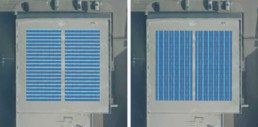
Yield per m².
| Assumption: | Face Off result |
|---|---|
| Base Assumption: 10/12 degrees | Win for East-West. 22.5% more yield/m². |
| Factor: Spacing of South facing | Can reduce difference to around 8% if weight is not an issue. |
The yield per module might be a little less in East-West facing systems, the total number of installed modules outweighs this, leading to much better total yields per m² roof surface. This difference can be as much as 25%, so symmetrical systems are the way to go when roof surface is limited.
Impact of increasing pitch and reducing row spacing of South facing systems is offset by other issues such as shading and ballast requirements.
Yield distribution.
| Assumption: | Face Off result |
|---|---|
| Base Assumption: Low module pitch (10-15) | Marginal win for East-West |
| Factor: Greater module pitches | Makes East-West more competitive by increasing self consumption. |
Another supposed advantage of symmetrical systems that is widely published is the distribution of yield over the day. Where a South facing system has a clear peak around noon, with solar panels facing East and West the yield is more evenly spread out. This results in a more steady production of kWh and a better match to the actual energy usage. However, the most common flat roof structures use a pitch between 10-15 degrees, so this advantage is really quite negligible as shown below.
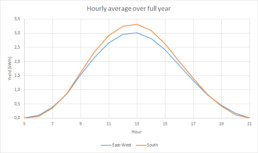
Because of the difference in azimuth, yield distribution differs over the course of a day.
Shade.
| Assumption: | Face Off result |
|---|---|
| Base Assumption: No Shade | Win for East-West |
| Factor: Morning or evening shade | Makes South more competitive. Morning or evening shade will result in greater shade losses for East-West facing modules |
When the modules are directly facing the sun they experience higher plane-of-array insolation – the amount of direct and indirect sunlight hitting the surface of the solar panel – which of course leads to higher yields. Since most shading occurs during sunrise and sunset, the general influence of shade is worse for symmetrical systems. Common rooftop obstacles such as air conditioning units and sky lights are easily capable of causing 5-10% shade losses for East-West systems if the PV array does not avoid appropriately and plan stringing accordingly.
The Autarco modelling software is designed to make exact shading calculations, making it possible to compare both alternatives on any given location.
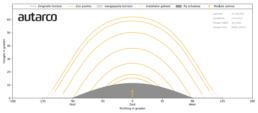
With modules facing south, there is a small amount of self-shading from one row to the next.
Mounting costs and ballast.
| Assumption: | Face Off result |
|---|---|
| Base Assumption: 10m roof height. | Clear win for East-West |
| Factor: Roof height or increase module pitch. | The higher roofs and greater pitches strengthen the East-West advantage. |
With a symmetrical (East-West) system, you make the most efficient use of the mounting system. Since there is hardly any space between the modules, there is no redundant mounting to be installed. Due to its nature of back to back modules, a symmetrical system is less influenced by wind loads. They form a closed system within itself, without the need to provide wind deflectors like South facing modules would need. You can save up to 15% on the costs for mounting when using a East-West facing system.
Apart from using less material per installed module, it saves on the need for ballast as well. This saves costs and labor, but more important, it lowers the total weight of a system, especially for roofs above 10 metres height. This can play an important role in the decision, mostly for industrial buildings where load bearing capacity of existing structures can be limited.
AC connection and other fixed costs.
Projects that have high fixed costs regardless of total system size also favour East-West systems. These could include things like;
- Grid connections
- Crane fees / scaffolding
Conclusion.
We hope you found this analysis interesting and useful. We are committed to making solar simpler and less risky for installers and owners of commercial PV systems. If you have any questions about how to choose the best solution for your project, please contact us.
Sunny February
At Autarco, we continuously monitor solar irradiation levels for locations where our PV systems are installed. By doing so, we are able to analyze whether the yields of these systems are as expected and all components work as they should. The collected data leads to interesting results when comparing one year with another or looking for differences between various locations around the globe.
It’s not uncommon that a months irradiation levels may change from year to year by up to 20%. This is one more reason an intelligent monitoring system that tracks your systems actual performance against actual weather conditions is so important.
See how Autarco can offer you this here.
Last winter was quite dark...
For example in the Netherlands, irradiance levels last December and January have been lower than the long term average. On top of that, snowfall led to small decreases in yield, mostly for flat-roof systems. However, since average yields in these winter months account for only a small part of the yearly total, the impact of an incidental snow cover is minimal. The Royal Dutch Meteorological Institute (KNMI) measured that the number of sun hours in December and January were both far below average, this had a big influence on irradiation levels in this period, as we saw in our satellite data as well. The winter months were truly dark this year!

... but February made up for it!
Fortunately, February 2018 showed an entirely different image. Sun hours are far above average values, even so that it is the second highest number since the KNMI start monitoring these data back in 1909. On our satellite data we see this resulting in irradiation levels that are indeed above average, up to 30%, depending on the location within the Netherlands. Together with the low temperatures and the days lengthening again, this boosts the overall performance of PV systems, resulting in good yields for this time of the year.

Clean2Antarctica
Zero-waste expedition to the South pole.
Autarco is powering the Solar Voyager vehicle in the cleanest expedition ever, Clean2Antarctica. Dutch explorer Edwin ter Velde is planning to complete the worlds first ever energy neutral and zero-waste expidition to the South Pole.
Read more about his mission here www.clean2antarctica.com
The last unspoiled continent.
The South Pole is located on the Antarctic. This is the last untouched continent of the world. The Antarctic is not owned by anyone. Luckily the Antarctic Convention is in place. Military missions should not be carried out, no raw materials should be mined and nobody should leave waste behind. How swell is that! That is what the whole world needs. And that is possible, if we collaborate genuinely. We, at Autarco, want to be part of this journey, to help our next generation.
Why is there the need to go to the Antarctic, the cleanest continent in the world? With this clean expedition, it will draw attention to the Antarctic Convention, which is to be extended in 2048 so that’ the thermostat of the world’ is preserved for future generations.
A clean earth and a climate that ensures that the earth is and remains more live-able for the next generations to come. That is why it is necessary to deal with mother nature more sensibly. Nature is cyclical and change is the only constant. And needs to STOP! We need to stop burning raw materials as once they disappear, they never come back as a raw material, never ever again.
A vehicle made from waste.
The Clean2Autartica team wants to drive up and down 2300km to the South Pole with a 100% Autarco solar-powered vehicle, autonomously without outside help. The car is built from waste material like plastic in co-creation, with individuals, government, business and youngsters who use their ideas and creativity to shape the future! It will prove that it is possible to build a car with combined knowledge, purely on solar energy and through clean technology. This first solar expedition team is therefore determined to be the cleanest expedition ever! No waste, no emission! You have to follow your dreams, dare to simply do it. We, Autarco, strongly believe in this philosophy and therefore support this expedition wholeheartedly.





